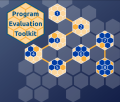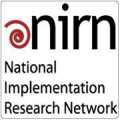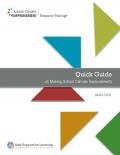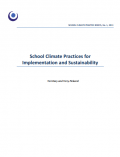
Implementation involves putting a plan into effect, including the process of monitoring progress, making adjustments, and evaluating impact.
Once school districts and communities have identified those areas of school climate and conditions for learning that need to be addressed, they must apply their data to make an informed decision about which programmatic interventions should be implemented to improve student outcomes. School districts and communities that develop strong partnerships with other child and youth serving systems increase the potential for positive student outcomes as they plan and implement evidence-based practices based on identified needs. A strong implementation plan contributes to the overall safety and supportiveness of learning environments to help all students achieve.
A programmatic intervention is any program, strategy, activity, service, or policy implemented in a school or community setting that:
- prevents and reduces youth crime, violence, harassment, bullying, and the illegal use of drugs, alcohol, and tobacco
- creates positive relationships between students and adults
- promotes parent and community engagement
- promotes the character, social, and emotional development of students
- provides or improves access to social services
- enables school communities to manage student behaviors effectively while lowering suspensions and expulsions
- provides other needed social and emotional supports for students
Programmatic interventions should be based on the best available evidence, including, where available, strong or moderate evidence.
Strong evidence means evidence from studies with designs that can support causal conclusions (i.e. studies with high internal validity), and studies that, in total, include enough of the range of participants and settings to support scaling up to the State, regional, or national level (i.e. studies with high external validity).
Moderate evidence means evidence from previous studies with designs that can support causal conclusions (i.e. studies with high internal validity) but have limited generalizability (i.e. moderate external validity) or from studies with high external validity, but moderate internal validity.
Implementation of programmatic interventions in your school or community is an ongoing process undertaken by school climate teams or others involved in improving student outcomes. Each year, the team should review collected data and implement those interventions that address identified areas of need. The following graphic provides a model for use by school climate teams and/or communities to identify and implement programmatic interventions.
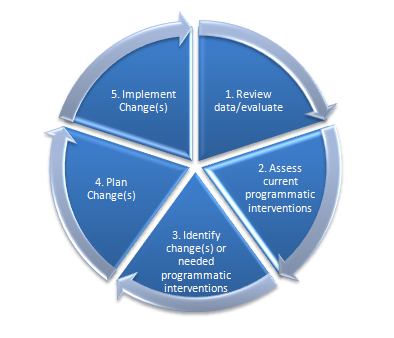
Our model of implementation is based upon research conducted by the National Implementation Research Network (NIRN). NIRN has identified Stages of Implementation that efforts must address in order to be successful: exploration and adoption, program installation, initial implementation, full implementation, innovation, and sustainability. These stages represent an iterative process, as efforts are reassessed or reevaluated in light of new realities.
Each year, survey data will help you identify and target areas in your school, district, or state that are in need of improvement. This ongoing data collection will guide you in revising and adjusting your larger implementation plan, while allowing you to focus resources in the areas of most need. Read brief descriptions of each step below. Once you're ready to begin the process, check out our helpful checklist for Identifying and Implementing Programmatic Interventions.
Begin by bringing together a school climate team, ideally making use of an existing team or group involved in school climate. Work together to review data and plan and implement programmatic interventions. Your team will need to:
- Develop a communication plan for documenting and describing your process and activities to key stakeholder groups. It is important to communicate team activities, timeline, and other relevant information to stakeholders on a regular basis.
- Analyze survey and incident data to determine needs and prevalence of need.
- Utilize the 3 Tier Model of Intervention to determine where to intervene based on student strengths and needs.
- Review existing strategic plans for the school, district, and/or community organizations involved to identify and align needs and priorities.
- Select areas in which to focus based on identified needs.
- Develop a shared vision and goals among all partners and stakeholders based on data and aligned needs and priorities.
Related Resources:
School Climate Webinar Series: School Based Climate Teams (Part 1)
School Climate Webinar Series: School Based Climate Teams (Part 2)
Implementation Webinar Series: Using Data to Identify Programmatic Intervention Needs (Section 2)
Identifying and Implementing Programmatic Interventions: Step 1 (DOC)
Assessment of Current Programmatic Interventions Addressing Conditions for Learning (DOC)
With your team, begin by identifying programmatic interventions and available resources that are currently in place within your school or community at each tier (individualized supports, early intervention, and school-wide interventions). It is important to review this data on current inventions at each tier to assess if you are successful in achieving intended outcomes. Interventions that are not successful, may need to be adapted, if possible, or replaced by a different intervention to meet your identified need.
Related Resources:
Assessment of Current Programmatic Interventions Addressing Conditions for Learning Tool (DOC)
Identifying and Implementing Programmatic Interventions: Step 2 (DOC)
Based on the identified need, data, and existing programmatic interventions, your team will determine what changes are necessary. You may find that your data supports the continued use of some existing interventions or that the intervention does not match the intended population it is serving. Your team might then decide to select an additional programmatic intervention. When selecting interventions, be sure to think about:
• Need
• Fit
• Available resources
• Strength of evidence
• Readiness for replication
• Capacity to implement
• Cost
When selecting programmatic interventions, be sure to focus on those that specifically address your identified needs and intended population, as revealed by your data. Ideally, your team will select one or more interventions for each tier to implement over the next year, at which time you will look at outcomes and impacts and make any adjustments as necessary.
Related Resources:
Implementation Webinar Series: Using Data to Identify Programmatic Interventions (Sections 3 and 4)
Identifying and Implementing Programmatic Interventions: Step 3 (DOC)
Selecting and Implementing Evidence-Based Module Series
Selecting Evidence-Based Programs Workbook
Directories of Programmatic Interventions
Youth.Gov Program Directory features evidence-based programs whose purpose is to prevent and/or reduce delinquency or other problem behaviors in young people. The Background & Methodology page describes how the Program Directory was developed and how programs are evaluated and categorized. The Research page describes risk and protective factors and how those factors are relevant to youth programs. It includes a biography of recent research.
Safe School Framework Implementation Toolkit (FIT), developed by the National Center for Healthy Safe Children, is designed for use by school-and community-based teams to implement a comprehensive approach to school safety, mental health promotion, and youth violence prevention. Teams based at community mental health agencies and youth-serving organizations working in law enforcement, juvenile justice, and social services can also use the toolkit.
Blueprints for Healthy Youth Development identifies, recommends, and disseminates programs for youth and families based on scientific evaluations and strong evidence of effectiveness. Programs are rated as Promising, Model, or Model Plus.
Institute of Education Science's (IES) What Works Clearinghouse (WWC) reviews research on programs, products, policies, and practices in education to provide educators with information needed to make evidence-based decisions.
Once your team has selected one or more programmatic interventions for implementation, you will begin to plan needed changes with your partners and other key stakeholders. Be sure you have information on all aspects of your selected interventions and have considered how the programs will address the identified needs, intended population, and create school-wide improvement of Conditions for Learning (see tiered models of intervention). Working with your team, develop a logic model that aligns with the vision, goals, activities, and intended outcomes. The logic model will help guide your team's planning and activities for the year as you develop your implementation strategies.
Related Resource:
Summary of NIRN's Stages of Implementation (DOC)
Identifying and Implementing Programmatic Interventions: Step 4 (DOC)
Implementation Webinar Series: Effective Planning Strategies for Program Intervention
At the completion of the planning phase of your implementation efforts, the team will begin the work of implementing your selected programmatic intervention(s) in each tier (individualized supports, early interventions, and school-wide supports). This will likely include:
• Conducting professional development and training activities
• Providing access to technical assistance and support
• Conducting regular monitoring of progress throughout the year
• Providing feedback about progress
• Assessing needs of implementers and responding as needed
As your team moves through implementation, you'll continue to gather, assess and analyze implementation data about progress, student outcomes and impacts, and other information, as relevant. This data will help your team continue to refine programmatic interventions, make adjustments, identify gaps in services, and assess any new needs or new populations in needs of service.
Related Resources:
Identifying and Implementing Programmatic Interventions: Step 5 (DOC)
Implementation Webinar Series: Implementing New Programs--The Impact of Current Practice
(Go see Step 1 above)
